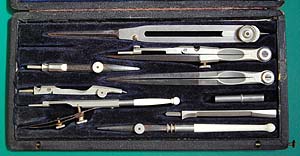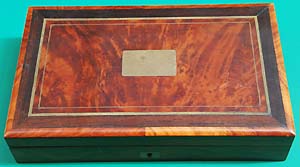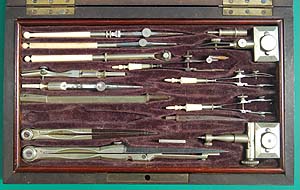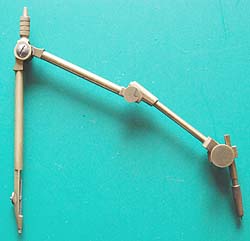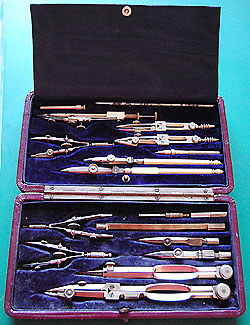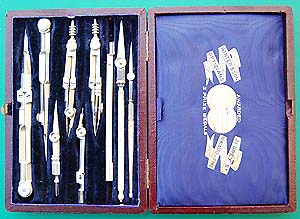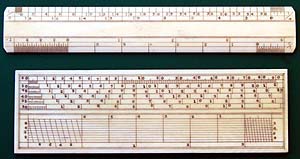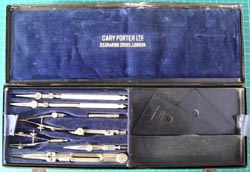













A magazine case of typical English hand made instruments of the traditional pattern. The case is oak, electrum bound, and measures 14.5 x 8.5 x 4.75 in. It has a lift out tray in the top, which houses the compasses, etc and a drawer, which springs out when released by the button on the left side. The case is incomplete and the ivory protractor and parallel rule, although typical, have been added.
The drawer of the magazine case which is fitted for watercolours (six remain, all by Winsor & Newton). The palette is by Reeves and there is a space under it for brushes. The set dates from circa 1900 and the cartouche on the lid is engraved H J Stanley, presumably the original owner, and many of the instruments have his initials engraved on them. These cases cost £20 or more when new.
A nineteenth century set of brass instruments in a mahogany box. These are typical of many sets of this period which are unsigned. They are of the traditional pattern in its later form with sector heads to the compasses and dividers in place of the long joint heads which were commonplace at the start of the century. The long, ivory handled pen on the left is not original and is probably French. The boxwood sector is normally housed under the tray containing the metal instruments.
A traditional pattern set by Patrick Adie of London in a morocco leather case, dating from about 1900.
Eight inch cases containing a “full set” of instruments, like this one, were sold by all of the major makers. Protractors, etc could be stored behind a flap in the lid.
Another eight inch, morocco leather case, retailed by Gamages of London.
A “full set” normally comprised a 6” or 4.5” compass with extension bar and fittings, 5” or 4” dividers, two bow compasses, three spring bows and two ruling pens. Sometimes there was also a pricker.
A large “Sandhurst” case from the late nineteenth century, sold by the Army & Navy Stores, intended for use by army officers. Unlike other ranks, who were issued with uniforms and equipment, officers had to purchase their own. Hence drawing equipment used by army officers does not bear the government broad arrow as it was the officer’s personal property.
A set of spring bows, English, circa 1900.
An English set dating from the late nineteenth century, which is of a pattern with a double jointed compass with plain points, which by that time had generally been superseded.
A cheap set of 'Foreign' instruments, almost certainly French. These unmarked sets were sold by many retailers and manufacturers for use by students. The quality is considerably inferior to British made sets. It dates from circa 1900 and the main material used is brass.
They can be found in both mahogany and rosewood veneered boxes and sometimes the instruments are nickel plated or nickel silver.
This set of French instruments is similar to the set above but is of better quality. The instruments are made of nickel silver, heavier in construction, have steel leaves in the joints, and nickel silver thumb screws instead of steel. The spring bows are much finer, with ivory handles and the pen handle unscrews to reveal a pricker. The divider is of the hairspring type. There is also a brass protractor similar to the one in the set above.
A small electrum set by Schoenner of Germany, dated 1912. This pattern of instruments was popular in the USA and several US firms sold similar instruments, made in Germany, under their own brand names (e.g. Post, K&E). Similar instruments were also made in Switzerland, for instance by Kern.
A Japanese set by Yasukawa & Co, Isezaki-cho, Yokohama. It is a curious mixture of French and English styles, both of which were probably obsolescent by the time that this set was made. The instruments are nickel-silver and the pens have bone handles, which unscrew to reveal prickers. The case is covered in green rexine.
Early 20th century set by Daimaru, Japan. This set is in the English style in nickel silver and bone. However the pen handles have tops that unscrew to reveal prickers at that end, which is quite un-English. The case is covered in brown leather and lined with dark blue silk and velvet.
A Cary Porter Ltd “Woolwich” set dating from the 1920s. The metal instruments are electrum. The lower pen was special to these sets and has an extended ferrule to house the pricker on the end of the ivory handle, which unscrews. The set also includes two vulcanite set squares, a set of marquoise scales and triangle and three chain scales (there should be four). The box is rather battered from hard use.
Small drawing instrument set by Auguste Patte, Ingénieur, Opticien, Arcades du Grand Hotel du Louvre, 168, Rue de Rivoli, Paris.
The instruments are brass with steel leaves in the joints, of quite reasonable quality, and probably date from the late nineteenth century. An extension bar and compass key are missing and one pen has its handle broken off.
Eugene Dietzgen 1188P set of nickel silver drawing instruments. Dietzgen were based in Chicago in the USA but like many US instrument ‘makers’ the instruments they sold were actually made in Germany. The compass and divider are stamped at the head ‘DRP’ (Deutsch Reich Patent), which tells us they are German and indeed this pattern of instrument, sometimes referred to as the ‘American Pattern’, is in fact a standard German and Swiss pattern of which the Schoenner set above is another example.
Frederick Post 1076’College’ set. These are also nickel silver instruments to a similar pattern to the Dietzgen ones, although with detail differences, such as the method of clamping the compass inserts in place.
Full set by J M & H Cronmire, 10 Bromehead Street, Commercial Road East, London in an eight inch rosewood veneered case. Their trade label was affixed to the underneath of the instrument tray and the ivory protractor, above, is also signed. They were at this address from 1865-69.
When I obtained this set the instruments were not located in the correct pockets and it has been a puzzle to work out their correct locations. I had not realised that in sets from the middle of the nineteenth century the spring bows did not necessarily have separate pockets but were sometimes arranged in a line in one large pocket as I have now arranged them. I posed the question of how they should be arranged to members of the Yahoo drawing instruments group (link on Links & Contacts page). Robert Pilla posted a picture of his Archbutt set of about the same date showing that the spring bows were arranged in this way.
The instrument in the uppermost pocket is a road pen. It will be noted that there is one instrument missing. This would have been a six inch plain divider.
I have shown the spring bows separately as they rather unusually have ivory handles.
Bow compass set by H Schery & Co, 134 Deansgate, Manchester, England. Electrum instruments. Morocco covered case. Early twentieth century.
Tubular brass set by James Parkes of Birmingham, dating from ca.1900. These cheap but robust sets were intended for use by students and were the subject of James Parkes’s patents. A slightly larger set is illustrated on the ‘Who Made Them’ page,. That set was a Department of Science & Art Reward set. Another example of a Reward set is shown below. The box is mahogany, lined with blue velvet.
Nickel silver full set by J Parkes & Son. The three spring bows are of a type usually found in French sets and were possibly bought in from a French maker by Parkes. They have ivory handles.
Department of Science and Art Reward set by T Grew of Plaistow, Essex. Typically for these sets, a couple of pieces are missing, probably a second pen and a pencil bow compass. They were typical student sets made of brass with long joint heads to the compass and dividers and no knee joint in the fixed leg of the compass. The block nib pen does not open for cleaning.
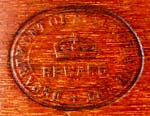 The Department of Science and Art Reward stamp in the centre of the mahogany box lid.
The Department of Science and Art Reward stamp in the centre of the mahogany box lid.
This nickel silver set appears to be of French manufacture and was said to date from the 1940s. The black leathercloth covered case is lined with blue silk and velvet and has a flap in the lid behind which is the typically French paper pocket for a protractor (missing). The proportional divider is only divided for lines.
French nickel silver and ivory set dating from ca. 1900. The instruments include a six inch compass and fittings, dividers, Swiss pattern beam compass fittings, three spring bows, two ruling pens, one with opening nib and pricker on the end of the handle which unscrews, and a dotted line pen with three wheels. A small compass and its fittings are missing. In the base of the box is a small wood triangle with angles of 75, 60 and 45 degrees. The mahogany carcased box is finely veneered with rosewood and a contrasting wood and has brass banding. It is lined with blue silk and purple velvet.
Jackson Bros, Leeds & Armley set of brass instruments. The pen has a bone handle and is of the type patented by J Parkes & Co. The compass and dividers also seem to be based on a Parkes patent design. They would have been intended for student use. The form of extension bar for the compass is unusual.
English pattern set, unsigned except for the larger pen, which is marked Dixon & Hempenstall. It probably dates from the early 20th century and appears to be complete with all its original items. Besides the English full set it contains a drop bow compass and a pricker of a pattern usually associated with Germany both of which are original to the set. The case is leather covered and lined with blue watered silk and blue velvet. The set also includes a knife key, a lead container with a screw top, a needle container and a lead pusher. The handle of the latter matches those of the spring bows.
Dixon & Hempenstall were set up in Dublin at 12 Suffolk Street in 1904 as opticians and retailed drawing and surveying instruments. They are still in business today as opticians in the modern sense.
T B Winter & Son, 21 Grey Street, Newcastle upon Tyne set dating from Ca. 1900. The small size electrum instruments are housed in a Morocco covered pocket case lined with blue silk and blue velvet. Under the flap inside the lid are an ivory rule and a 5” ivory protractor, which are shown below. The 1881 census lists a Thomas Burgess Winter, optician, aged 50, living in Jesmond, Northumberland.





Traditional sets as I have defined them are those designs that developed in the mid nineteenth century and continued to be made for the next 100 years or more until gradually superseded by later patterns. They were generally hand made or at least hand finished, quite heavy, and mostly designed to last a lifetime or more.

This large French set is unsigned. The nickel silver and ivory instruments are contained in a 2 tier mahogany box. In addition to the usual compasses, dividers, spring bows and ruling pens it has a set of beam compass fittings and a proportional divider. It dates from about 1900.
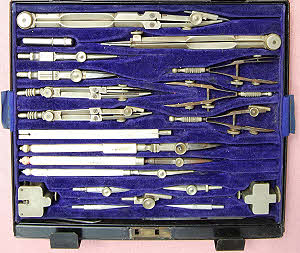
A set of electrum instruments by B J Hall & Co Ltd, possibly dating from the 1920s. In addition to the ‘full set’ of instruments, it also includes a set of beam compass fittings and it is complete with a knife key, compass key and tube for spare leads. Being in a japanned steel box, the set was intended for use in the field, probably originally belonging to a surveyor as there were two offset scales below the tray.
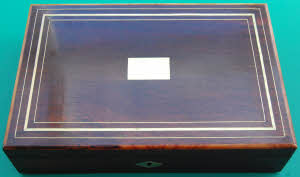

This large French set of nickel silver and ivory instruments probably dates from about 1900. It has a nice, eight-inch, ivory rule with nickel-silver handle. The base of the box contained an assortment of items that were probably added by its owners. These include 45 and 67.5 degree set squares made of wood and two wood curves, one of which is egg shaped. There is also a box of A W Faber leads for artist’s pencils and an A W Faber improved eraser. The lid is lined with maroon silk and this is on a flap that opens to reveal two steel erasing shields where there should be a semi-circular protractor.
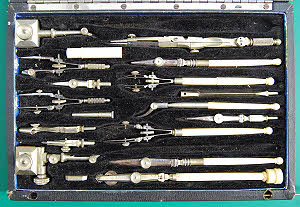
A large Japanese set “No 1” that has some unusual instruments including a dotted line pen, a curved line pen, a road pen and a curved line road pen. It is a mix ofEnglish & French styles. It is missing the middle size ruling pen and a proportional divider.
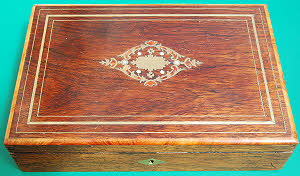
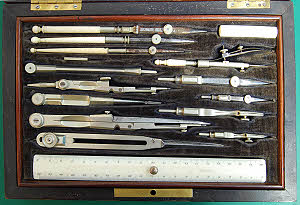
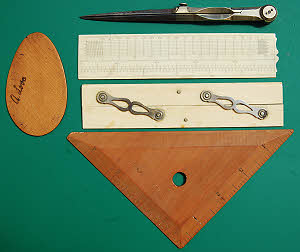
Another large French set by the same maker as the one above the Japanese No 1 set. The dividers are an English replacement and, except for the pearwood oval, the items illustrated from below the tray are also English additions. The rosewood box is inlaid with brass and mother of pearl. The instruments are ivory and nickel silver.
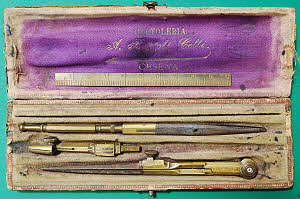
A small set of typical Italian drawing instruments sold by Cartoleria A.????? Celli, Cesena. The compass is missing its ink point and the hinged nib pen is missing its screw. The case is very worn. The brass scale is 10 cm long, graduated in cm and mm. Mid to late 19th century. Brass and steel instruments.
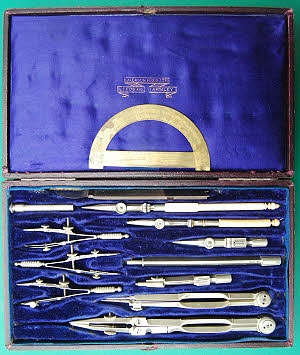
A Jackson Bros set of mainly English instruments, ca.1900. It is doubtful whether Jackson Bros made any of these instruments. Most of their sets that I have seen have small size German or Swiss made instruments in them and the smaller ruling pen is an example of this. This pen is signed Jackson Bros but the larger one isn’t. Both the compass and dividers are signed Jackson Bros as well.
The cheap, brass protractor may not be original. It is typical of those found in student sets made in France. The case lid is covered in Morocco leather.
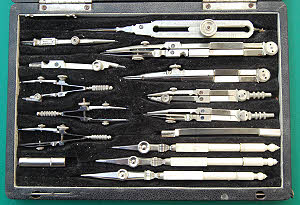

Unlike the Yasukawa set shown earlier that was modelled on French instruments, This set is modelled on English ones, though with the usual modification to the pens.
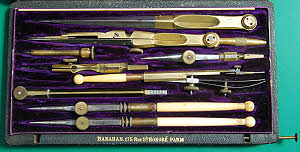
Leather pocket cased set of instruments by Baraban, 175 Rue St Honore, Paris, dating from about 1900. The instruments of brass, steel and ivory comprise dividers, a compass half set, a pen spring bow, two ruling pens and an ivory scale rule.
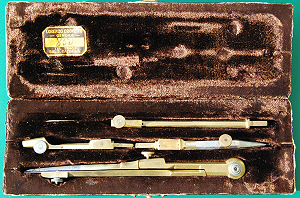
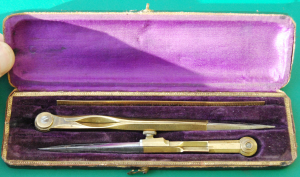
A small Compassi Milano Precisione brass compass set in a leatherette covered, deep
purple velvet lined case, complete with adjusting key.There is a label in the lid
for Lorenzo Crovetto, Genova, presumably the retailer. The divider point of the compass
is a replacement.
Asmall compass set by S Piancastelli of Florence in a leather covered, mauve silk
and velvet line case. There is a 12 cm brass rule in addition to the compass and
the dividers. The latter is probably a replacement that happens to fit in the space
for the ink and pencil inserts for the compass.

Jackson Bros, Leeds and Armley, set of brass, tubular pattern, instruments. They
are clearly to the design patented by James Parkes & Son who presumably made these
for Jackson Bros The sector head design, rolled brass tube legs and patent pen construction
are all Parkes features, as is the design of the lengthening bar. The missing item
was probably a container for spare leads as Jackson’s catalogue states they did not
provide a divider point for the compass if the set contained dividers.





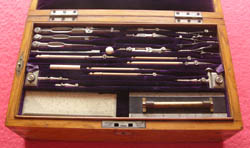
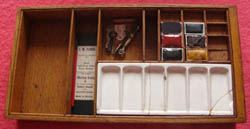
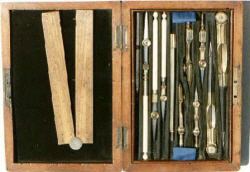
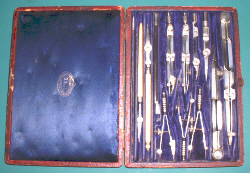
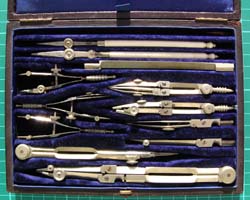
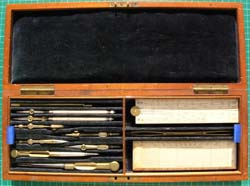
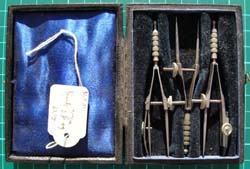

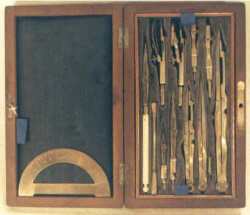
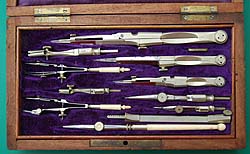
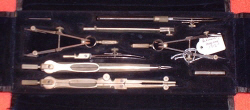
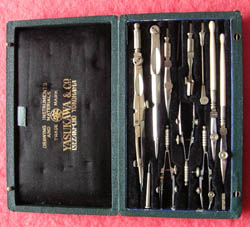
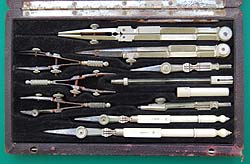
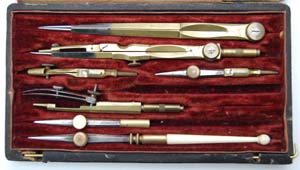
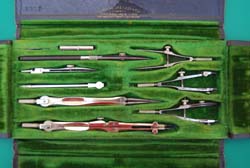

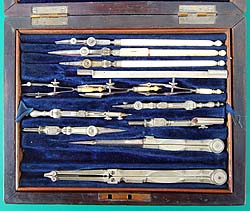
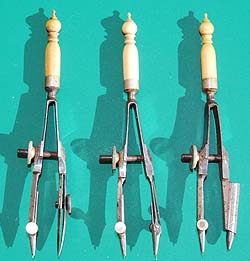


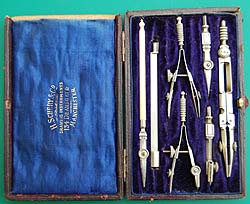
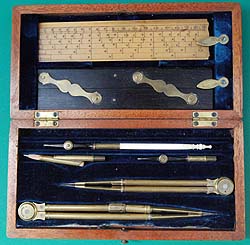
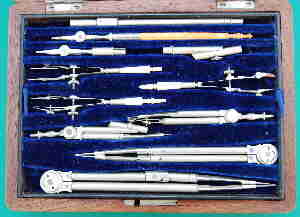
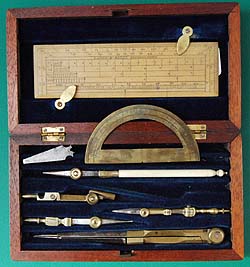
 The Department of Science and Art Reward stamp in the centre of the mahogany box lid.
The Department of Science and Art Reward stamp in the centre of the mahogany box lid.